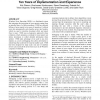51 search results - page 3 / 11 » Isolating Intrusions by Automatic Experiments |
DSN
2006
IEEE
15 years 5 months ago
2006
IEEE
One way to prevent control hijacking attack is to compare a network application’s run-time system calls with a pre-defined normal system call behavior model, and raise an alert...
101
click to vote
ICPR
2000
IEEE
16 years 24 days ago
2000
IEEE
Speech can be represented as a time/frequency distribution of energy using a multi-band filter bank. A Markov random field model, which takes into account the possible time asynch...
EJASMP
2010
14 years 6 months ago
2010
Computer Assisted Language Learning (CALL) applications for improving the oral skills of low-proficient learners have to cope with nonnative speech that is particularly challengin...
ACSAC
2006
IEEE
15 years 5 months ago
2006
IEEE
We present NetSpy, a tool to automatically generate network-level signatures for spyware. NetSpy determines whether an untrusted program is spyware by correlating user input with ...
SOSP
2009
ACM
15 years 8 months ago
2009
ACM
Windows Error Reporting (WER) is a distributed system that automates the processing of error reports coming from an installed base of a billion machines. WER has collected billion...




